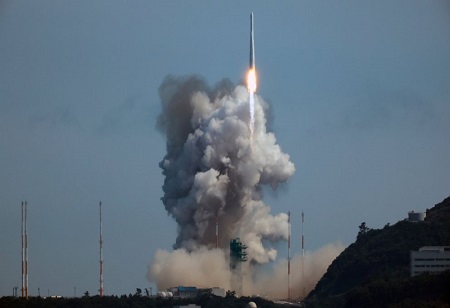
S.Korea successfully launches homegrown space rocket

 South Korea launched its homegrown space rocket Nuri in the second attempt to put satellites into orbit, a critical mission for the country's space programme.
South Korea launched its homegrown space rocket Nuri in the second attempt to put satellites into orbit, a critical mission for the country's space programme.
According to the Ministry of Science and ICT, the 200-tonne Nuri, also known as KSLV-II, blasted off from the Naro Space Centre in the country's southern coastal village of Goheung, a trusted source reported.
The ministry said the rocket completed its launch as planned and aerospace engineers were conducting detailed data analysis to determine whether the satellites successfully reached their orbits. The result of the launch is expected to be announced.
South Korea had planned to launch the three-stage rocket last week, but a technical glitch in the oxidizer tank sensor forced the country to postpone the liftoff.
In a meeting of Nuri's launch management committee Monday, the science ministry and the Korea Aerospace Research Institute (KARI) concluded that Nuri's final technical inspection proceeded without any problems. The weather forecast also satisfied launch conditions.
A successful launch would make South Korea the seventh country in the world to have developed a space launch vehicle that can carry a more than 1-tonne satellite, after Russia, the US, France, China, Japan and India.
It would also mean South Korea will now have secured the key independent technology for developing and launching space rockets carrying homegrown satellites, opening up a new era in the country's space program.
Today's launch is also Nuri's second liftoff after its first attempt ended in failure last year.
In October, Nuri successfully flew to its target altitude of 700 kilometres but failed to put a dummy satellite into orbit, as its third-stage engine burned out earlier than expected.
KARI engineers reinforced an anchoring device of the helium tank inside Nuri's third-stage oxidizer tank.
This time, Nuri was loaded with a 162.5-kilogram performance verification satellite meant to test the rocket's capabilities, and four cube satellites, developed by four South Korean universities for academic research purposes, along with a 1.3-tonne dummy satellite.
South Korea, a relative latecomer to the global space development race, has invested nearly US$1.8 billion in building Nuri since 2010. South Korea's rocket launches ended in failures in 2009 and 2010.
In 2013, South Korea successfully launched its first-ever Naro space rocket, though its first stage was built in Russia.
The country aims to conduct four additional Nuri rocket launches by 2027. South Korea has also launched a preliminary feasibility study for the successor to the Nuri with the goal of sending a lunar landing module to the moon in 2031, the report said.

